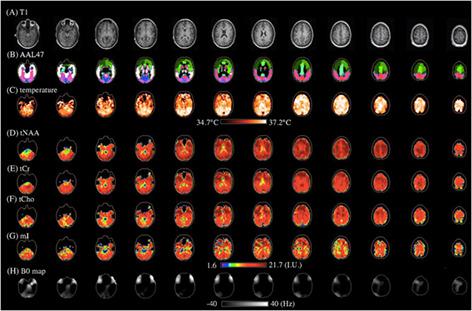当前位置:
X-MOL 学术
›
NMR Biomed.
›
论文详情
Our official English website, www.x-mol.net, welcomes your
feedback! (Note: you will need to create a separate account there.)
Reproducibility of whole-brain temperature mapping and metabolite quantification using proton magnetic resonance spectroscopy.
NMR in Biomedicine ( IF 2.7 ) Pub Date : 2020-04-29 , DOI: 10.1002/nbm.4313 Yue Zhang 1, 2 , Edward Taub 1 , Christina Mueller 1 , Jarred Younger 1 , Gitendra Uswatte 1, 3 , Thomas Patrick DeRamus 4, 5 , David C Knight 1
NMR in Biomedicine ( IF 2.7 ) Pub Date : 2020-04-29 , DOI: 10.1002/nbm.4313 Yue Zhang 1, 2 , Edward Taub 1 , Christina Mueller 1 , Jarred Younger 1 , Gitendra Uswatte 1, 3 , Thomas Patrick DeRamus 4, 5 , David C Knight 1
Affiliation

|
Assessing brain temperature can provide important information about disease processes (e.g., stroke, trauma) and therapeutic effects (e.g., cerebral hypothermia treatment). Whole‐brain magnetic resonance spectroscopic imaging (WB‐MRSI) is increasingly used to quantify brain metabolites across the entire brain. However, its feasibility and reliability for estimating brain temperature needs further validation. Therefore, the present study evaluates the reproducibility of WB‐MRSI for temperature mapping as well as metabolite quantification across the whole brain in healthy volunteers. Ten healthy adults were scanned on three occasions 1 week apart. Brain temperature, along with four commonly assessed brain metabolites—total N ‐acetyl‐aspartate (tNAA), total creatine (tCr), total choline (tCho) and myo‐inositol (mI)—were measured from WB‐MRSI data. Reproducibility was evaluated using the coefficient of variation (CV ). The measured mean (range) of the intra‐subject CV s was 0.9% (0.6%‐1.6%) for brain temperature mapping, and 4.7% (2.5%‐15.7%), 6.4% (2.4%‐18.9%) and 14.2% (4.4%‐52.6%) for tNAA, tCho and mI, respectively, with reference to tCr. Consistently larger variability was found when using H2O as the reference for metabolite quantifications: 7.8% (3.3%‐17.8%), 7.8% (3.1%‐18.0%), 9.8% (3.7%‐31.0%) and 17.0% (5.9%‐54.0%) for tNAA, tCr, tCho and mI, respectively. Further, the larger the brain region (indicated by a greater number of voxels within that region), the better the reproducibility for both temperature and metabolite estimates. Our results demonstrate good reproducibility of whole‐brain temperature and metabolite measurements using the WB‐MRSI technique.
中文翻译:

使用质子磁共振波谱进行全脑温度测绘和代谢物定量的再现性。
评估大脑温度可以提供有关疾病过程(例如中风、创伤)和治疗效果(例如脑低温治疗)的重要信息。全脑磁共振光谱成像 (WB-MRSI) 越来越多地用于量化整个大脑的大脑代谢物。然而,其估计脑温度的可行性和可靠性需要进一步验证。因此,本研究评估了 WB-MRSI 在健康志愿者全脑温度测绘和代谢物定量方面的可重复性。10 名健康成人每隔 1 周接受 3 次扫描。脑温度,以及四种常用评估的脑代谢物——总氮-乙酰-天冬氨酸 (tNAA)、总肌酸 (tCr)、总胆碱 (tCho) 和肌醇 (mI) - 根据 WB-MRSI 数据测量。使用变异系数 ( CV )评估重现性。对于脑温度映射,受试者内部CV s的测量平均值(范围)为 0.9% (0.6%-1.6%),4.7% (2.5%-15.7%)、6.4% (2.4%-18.9%) 和 14.2 % (4.4%-52.6%) 分别为 tNAA、tCho 和 mI,参考 tCr。使用 H 2时发现始终存在较大的可变性O 作为代谢物定量的参考:tNAA 为 7.8% (3.3%‐17.8%)、7.8% (3.1%‐18.0%)、9.8% (3.7%‐31.0%) 和 17.0% (5.9%‐54.0%),分别为 tCr、tCho 和 mI。此外,大脑区域越大(由该区域内的体素数量越多表示),温度和代谢物估计的可重复性就越好。我们的结果证明了使用 WB-MRSI 技术对全脑温度和代谢物测量的良好重现性。
更新日期:2020-04-29
中文翻译:

使用质子磁共振波谱进行全脑温度测绘和代谢物定量的再现性。
评估大脑温度可以提供有关疾病过程(例如中风、创伤)和治疗效果(例如脑低温治疗)的重要信息。全脑磁共振光谱成像 (WB-MRSI) 越来越多地用于量化整个大脑的大脑代谢物。然而,其估计脑温度的可行性和可靠性需要进一步验证。因此,本研究评估了 WB-MRSI 在健康志愿者全脑温度测绘和代谢物定量方面的可重复性。10 名健康成人每隔 1 周接受 3 次扫描。脑温度,以及四种常用评估的脑代谢物——总氮-乙酰-天冬氨酸 (tNAA)、总肌酸 (tCr)、总胆碱 (tCho) 和肌醇 (mI) - 根据 WB-MRSI 数据测量。使用变异系数 ( CV )评估重现性。对于脑温度映射,受试者内部CV s的测量平均值(范围)为 0.9% (0.6%-1.6%),4.7% (2.5%-15.7%)、6.4% (2.4%-18.9%) 和 14.2 % (4.4%-52.6%) 分别为 tNAA、tCho 和 mI,参考 tCr。使用 H 2时发现始终存在较大的可变性O 作为代谢物定量的参考:tNAA 为 7.8% (3.3%‐17.8%)、7.8% (3.1%‐18.0%)、9.8% (3.7%‐31.0%) 和 17.0% (5.9%‐54.0%),分别为 tCr、tCho 和 mI。此外,大脑区域越大(由该区域内的体素数量越多表示),温度和代谢物估计的可重复性就越好。我们的结果证明了使用 WB-MRSI 技术对全脑温度和代谢物测量的良好重现性。











































 京公网安备 11010802027423号
京公网安备 11010802027423号